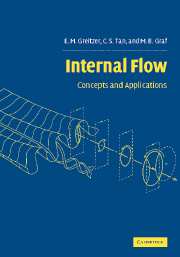Book contents
- Frontmatter
- Contents
- Preface
- Acknowledgements
- Conventions and nomenclature
- 1 Equations of motion
- 2 Some useful basic ideas
- 3 Vorticity and circulation
- 4 Boundary layers and free shear layers
- 5 Loss sources and loss accounting
- 6 Unsteady flow
- 7 Flow in rotating passages
- 8 Swirling flow
- 9 Generation of streamwise vorticity and three-dimensional flow
- 10 Compressible internal flow
- 11 Flow with heat addition
- 12 Non-uniform flow in fluid components
- References
- Supplementary references appearing in figures
- Index
3 - Vorticity and circulation
Published online by Cambridge University Press: 14 January 2010
- Frontmatter
- Contents
- Preface
- Acknowledgements
- Conventions and nomenclature
- 1 Equations of motion
- 2 Some useful basic ideas
- 3 Vorticity and circulation
- 4 Boundary layers and free shear layers
- 5 Loss sources and loss accounting
- 6 Unsteady flow
- 7 Flow in rotating passages
- 8 Swirling flow
- 9 Generation of streamwise vorticity and three-dimensional flow
- 10 Compressible internal flow
- 11 Flow with heat addition
- 12 Non-uniform flow in fluid components
- References
- Supplementary references appearing in figures
- Index
Summary
Introduction
In many internal flows there are only limited regions in which the velocity can be considered irrotational; i.e. in which the motion is such that particles travel without local rotation. In an irrotational, or potential, flow the velocity can be expressed as the gradient of a scalar function. This condition allows great simplification and, where it can be employed, is of enormous utility. Although we have given examples of its use, potential flow theory has a narrower scope in internal flow than in external flow and the description and analysis of non-potential, or rotational, motions plays a larger role in the former than in the latter. One reason for this difference is the greater presence of bounding solid surfaces and the accompanying greater opportunity for viscous shear forces to act. Even in those internal flow configurations in which the flow can be considered inviscid, however, different streamtubes can receive different amounts of energy (from fluid machinery, for example), resulting in velocity distributions which do not generally correspond to potential flows. Because of this, we now examine two key fluid dynamic concepts associated with rotational flows: vorticity, which has to do with the local rate of rotation of a fluid particle, and circulation, a related, but more global, quantity.
Before formally introducing these concepts, it is appropriate to give some discussion concerning the motivation for working with them, rather than velocity and pressure fields only. The equations of motion for a fluid contain expressions of forces and acceleration, derived from Newton's laws.
- Type
- Chapter
- Information
- Internal FlowConcepts and Applications, pp. 104 - 165Publisher: Cambridge University PressPrint publication year: 2004

